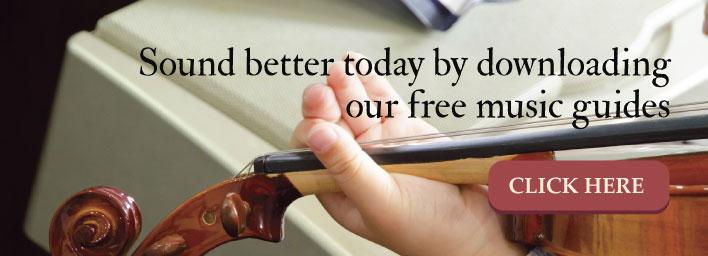Beginner Violinists: How to Make Each Note You Play Sound Better

Few things are as vexing to beginner violinists as the sporadic, yet persistent squeaks that occur while practicing and learning to play. This typically happens because of improper bow movement, pressure, or placement, which means that practicing your straight bow and other exercises will be essential for eliminating it.
However, there are also other culprits. The dreaded squeak is sometimes the result of easily fixable issues. Knowing what to look for and how to correct such situations will advance your progress as a violinist and help you deliver better performances. First, make sure that your violin isn’t suffering from any of these possible problems, and then you can concentrate on improving your bowing technique.
Rosin Overload
Having rosin build-up on your strings can cause them to squeak, especially the E string (the most frequent offender). A good way to avoid excess rosin is to make sure to wipe off your strings and your violin after playing it, an important step that beginner violinists should make a habit. You can purchase cloths and cleaning materials from your local instrument dealer, and if necessary, have a replacement installed for your gunked-up E string.
E String Sleeve
Another thing that can negatively affect the sound you create is related to the sleeve that is on your E string. This little tube protects your bridge (keeps the very thin E string from cutting into it), but if it has moved too far forward (towards the scroll), it can cause squeaking. Make sure that it is positioned just far enough forward to protect your bridge, with the majority of the sleeve located toward the bottom.
Bridge Misalignment
The bridge of your violin is held in place by the tension created in the strings. It isn’t stationary. And because of frequent tuning, the bridge can eventually begin to slant forward, backward, or just plain crookedly, which creates squeaking noises while you’re playing. Your bridge should be perfectly positioned, roughly aligned with the notches in the f-holes, sitting perpendicular to both the top plate of your violin and the tailpiece. Always check your bridge position after tuning your violin.
Weather Fluctuations
Beginner violinists will swiftly learn that sometimes squeaks occur because of sharp changes in humidity. For example, going from dry air in winter to months of rain in spring will cause your violin to soak up the additional moisture in the air, which can affect how it resonates. You can make your notes sound better by investing in a small case humidifier to offset some of the affects during this time.
Other String Identifiers
Sometimes, your E string simply needs replaced, or your fine tuners have been bent or are otherwise damaged. Either one of these situations can cause problems with your sound. By checking to ensure that both of these items are alright, you can help reduce unpleasant squeaks.
Bowing Technique
With beginner violinists, the bowing technique is responsible for most of problem. It really is a good idea to practice your straight bow exercises in front of a mirror, s-l-o-w-l-y, so that you can observe how your wrist and arm look when you bow correctly. Seeing it often helps.
Practicing in front of a mirror will also allow you to recognize when you’re not playing at the perfect spot. For example:
- Crooked Bow—you know of course, like all beginner violinists, that maintaining a straight bow stroke is essential for playing the violin.
- Bow too close to the bridge—again, even if you are bowing straight, if your bow isn’t located “on the highway,” your playing won’t sound right.
- Tilted Bow—remember to maintain flush contact with the “ribbon” of bow hair on the string.
A couple tips for keeping your bow motion straight:
- Move from the elbow, not the shoulder. It’s so natural to want to move your bowing arm from the shoulder joint, but this will only cause problems with your sound. Practice moving your arm from the elbow even when you aren’t playing.
- Use a straight bow guide. You can purchase a fancy one, but beginner violinists really benefit from having a bow guide, so you can make your own using either two plastic straws or two short pieces of paper (rolled up to resemble a drinking straw). Place one straw or tube of paper upright into the top circle of each f-hole. Do this very gently! The idea is to create a guide for your bow that keeps it in the proper playing position while you make your stroke, right below the fingerboard but not too close to the bridge.
As a beginner violinist, you can improve your sound by practicing your straight bow and making sure that your violin is in great playing condition every time you play. 

